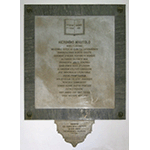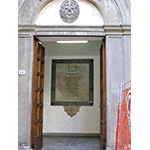Biblioteca Statale di Lucca [Lucca State Library]
The first core of the Biblioteca Statale di Lucca came from the Library of the Order of Regular Clerics of the Mother of God, founded in the 17th century by Abbot Girolamo Minutoli. In 1780 it became part of the Pio Istituto di San Frediano, delegated to public studies by a decision of the Lucca Senate. In 1791, the Republic of Lucca conferred on it printing rights, thanks to which it could receive free of charge all of the publications put out by the State. Opened to the public with a solemn ceremony on November 13, 1794, the library subsequently incremented its assets by acquiring the ample library of the Lucca physician and botanist Francesco Maria Fiorentini (1603-1673). But on the evening of January 30, 1822, a devastating fire sent up in flames a great number of texts. In 1861 the Library became the property of the Kingdom of Italy and in 1866 it acquired nearly 90,000 volumes coming from the libraries of the suppressed monasteries and convents. In 1877 it was moved to the premises of the former convent of Santa Maria Corteorlandini, which it still occupies today. The original library of the Order of Regular Clergy (about 13,000 volumes) has been placed in the splendid seventeenth-century salon known as the Hall of Santa Maria Nera.
In addition to its conspicuous heritage of books (about 365,000 volumes), the library contains rare editions and illuminated manuscripts of great value, various historical-scientific texts, a large group of autographs, an important repertory of texts on Italian history, a large part of the Fiorentini Herbarium, as well as a celestial globe and a terrestrial one by Robert de Vaugondy Didier, printed in Paris in 1773. It also has the library of the Accademia Lucchese di Scienze, Lettere ed Arti. on loan.
Noteworthy among the Library’s important historical-scientific works are: an ancient codex in medicine dating from the Carolingian Age, "Herbolarium et materia medica", the oldest work in the Library; an abacus book from the 14th century; the Libro di disegni d'orologi e d'altre figure (book of drawings of clocks and other figures) by Benedetto Sanminiati; a printed edition from 1482 of Ptolemy’s Cosmography; a treatise on arithmetic, geometry and proportions dated 1494 by Luca Pacioli; an Latin edition published in 1505 of Euclid’s Elements, a 1568 edition of the De humani corporis fabrica by Andrea Vesalio, the Lucca edition of the Enciclopédie of Diderot and d'Alembert; the Anatomia per uso degli studiosi di scultura e pittura (anatomy for the use of scholars of sculpture and painting) by Paolo Mascagni; and the Flora italiana by Gaetano Savi.
The Fiorentini Herbarium, composed of fifteen volumes, includes both indigenous and exotic plants (approximately 2,300 samples), collected by Francesco Maria Fiorentini starting in 1644. Of the 15 volumes that make up the original Herbarium, 11 (mss. 1223-1233) were acquired by the Library in 1802, while the other 4 (mss. 3224-3227), previously belonging to Charles Ludwig of Bourbon, Duke of Lucca, and then acquired by the Palatine Library of Parma, arrived only in 1934, through the initiative of the Director of the time.
At the Convent of Santa Maria Corteorlandini, before the Library was moved there, the Canon Michele Bertini, formerly astronomical calculator of the "Specola di Marlia" and then director of the public Lyceum of Lucca, had set up a little astronomical observatory, where in 1826 he brought some instruments from the Marlia observatory, which had by then ceased to carry out its activity. Of the astronomical observatory, no trace has remained.
****************************
Texts by Graziano Magrini
English translation by Catherine Frost
Last update 11/feb/2008





